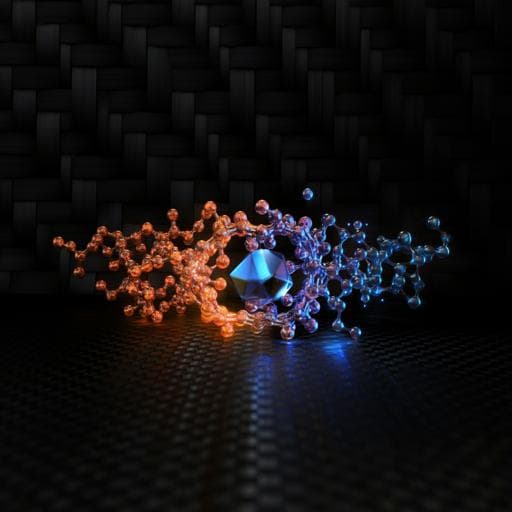
Chemistry
Stabilization of gamma sulfur at room temperature to enable the use of carbonate electrolyte in Li-S batteries
R. Pai, A. Singh, et al.
This groundbreaking study by Rahul Pai, Arvinder Singh, Maureen H. Tang, and Vibha Kalra reveals the stabilization of a rare monoclinic γ-sulfur phase within carbon nanofibers, enabling unprecedented performance in Lithium-Sulfur batteries for 4000 cycles, possibly revolutionizing high-energy-density battery technology.
~3 min • Beginner • English
Introduction
State of the art lithium-sulfur (Li-S) batteries offer an order of magnitude higher theoretical energy density than conventional lithium-ion batteries, with sulfur being abundant and environmentally friendly. However, Li-S systems face major challenges: sulfur and Li₂S are insulating, limiting utilization, and dissolved intermediate lithium polysulfides (LiPs) cause shuttle, harming coulombic efficiency and capacity retention. Much prior work mitigates shuttle in ether-based electrolytes, which are volatile and present safety concerns (e.g., DME boiling point 42 °C), limiting practicality beyond room temperature. Carbonate-based electrolytes, widely used and safer in Li-ion batteries, react irreversibly with polysulfides to form thiocarbonate and ethylene glycol, shutting down Li-S cells. A few recent studies showed Li-S operation in carbonates via nanoconfinement (sub-nm carbon pores), reporting single-plateau discharge and limited cycling, but with unclear reactant/product characterization, stringent pore-size requirements, and limited sulfur loadings. There are no reports using sulfur via a non-confinement approach in carbonate-based Li-S systems.
In this study, the authors synthesize and stabilize a novel γ-monoclinic phase of sulfur on carbon nanofibers (CNFs), enabling carbonate-electrolyte Li-S batteries to operate with high reversible capacity and exceptional cycle life. Despite exposed, unconfined sulfur, cells stabilize near 800 mAh g⁻¹ within a few cycles and retain ~650 mAh g⁻¹ after 4000 cycles with a ~0.0375% per-cycle decay, attributed to an altered redox that directly converts γ-sulfur to Li₂S without intermediate polysulfides.
Literature Review
- Ether-based Li-S research dominates, focusing on mitigating polysulfide shuttle; however, ethers are volatile with low flash points, hindering practical deployment at elevated temperatures.
- Carbonate electrolytes are safer and well understood from Li-ion batteries but react irreversibly with polysulfides, historically causing Li-S cell failure after the first discharge.
- A few reports (e.g., Xin et al.; Fu et al.) used sub-nanometer carbon pores (≈0.4–1 nm) to confine sulfur, proposing formation of small allotropes (S2–S4) or solid-state lithiation of confined S8, yielding single-plateau discharge and limited stable cycling (≈100–200 cycles) in carbonates. These approaches impose stringent pore-size control, limit achievable sulfur loadings, and often lack direct characterization of initial sulfur phases and discharge/charge products, leaving the storage mechanism unclear.
- No prior work reported non-confinement sulfur approaches in carbonate-based Li-S, nor stabilization and utilization of γ-monoclinic sulfur at room temperature for long-term cycling.
Methodology
Materials: PAN (Mw 150,000 g mol⁻¹), DMF, sulfur (99.998%), EC, DEC, LiNO₃, DME, LiPF₆ (battery grade), DOL, LiTFSI. All used as received.
Synthesis of CNFs: Electrospinning 10 wt% PAN in DMF; syringe pump feed 0.2 mL h⁻¹; 18-gauge needle; tip-to-collector distance 6 in; applied voltage 7–8 kV; RH <15%. As-spun mats stabilized at 280 °C for 6 h (air), carbonized to 900 °C in N₂ (2.5 °C min⁻¹ ramp), then CO₂ activation for 1 h in a tube furnace; cooled at 2 °C min⁻¹ to RT.
γ-Sulfur deposition: CNF discs (Ø 11 mm) dried at 150 °C under vacuum overnight; placed in an in-house SS316 autoclave with sulfur reservoir beneath and perforated electrode stage above; treated at 180 °C for 24 h; slow-cooled to RT over 6–8 h. Resulting sulfur content ≈50 wt% (TGA). The process yields room-temperature-stable γ-monoclinic sulfur on CNFs.
Characterization: SEM (Zeiss Supra 50 VP; EDX mapping) for morphology/elemental distribution; N₂ sorption (−196.15 °C; degassed at 150 °C) for BET surface area and pore distribution. XRD (Rigaku SmartLab, Cu Kα, 40 kV, 44 mA, step 0.02°, 2θ = 10–70°). XPS (PHI Versa Probe 5000, Al Kα, 200 µm spot, 23.5 eV pass energy; calibration via valence edge; Shirley background). TGA (TA Instruments 2950; Ar flow; 5–10 °C min⁻¹ ramp to 600 °C).
Electrochemistry: CR2032 coin cells assembled in Ar glovebox. Cathodes: as-transferred freestanding CNFs with ≈45–50 wt% S; S loading 0.5–5 mg cm⁻² (stacking to increase loading). Counter/reference: 13 mm Li discs from 0.75 mm Li foil. Separator: Celgard 2325, 25 µm tri-layer. Electrolytes: Ether: 1.0 M LiTFSI in DME:DOL (1:1 v/v) + 1 wt% LiNO₃. Carbonate: 1.0 M LiPF₆ in EC:DEC (1:1 v/v). E/S = 20 for all tests. Cycling: galvanostatic 1.0–3.0 V vs Li/Li⁺ (Maccor 4000/Neware BTS 4000). CV: 1.0–3.0 V, 0.01–0.5 mV s⁻¹ (Biologic VMP3). EIS: 100 kHz–100 Hz? (reported 100 to 100 MHz) with 10 mV AC amplitude, measured vs potential during cycling.
Post-mortem: Cells cycled (e.g., fifth charge/discharge at 0.05 C), rinsed with EC:DEC, dried under Ar and dynamic vacuum (48 h), transferred via sealed holder to XPS/XRD. SEM/TEM (including HRTEM) on discharged/charged electrodes to identify Li₂S lattice fringes (≈3.30 Å, (111) of cubic Li₂S).
Key Findings
- Stabilization of γ-monoclinic sulfur at room temperature on CNFs after autoclave vapor deposition and slow cooling; phase remains stable for ≥2 years.
- Sulfur distribution: uniform coating on CNFs with evidence of both partial pore filling and exposed, unconfined sulfur; BET surface area drops from 458 to 3.14 m² g⁻¹ post-deposition, indicating pore occupation; sulfur content ≈50 wt% (TGA).
- Electrochemical signature in carbonates: single discharge plateau at ≈2.0 V and single charge plateau at ≈2.2 V across all cycles, versus the canonical two plateaus in ether electrolytes; CV shows one redox peak in EC:DEC versus two in DME:DOL.
- Ultra-long cycling in carbonate electrolyte: at 0.5 C, capacity stabilizes to ≈800 mAh g⁻¹ within a few cycles with ≈0.0375–0.04% per-cycle decay; retains ≈650–658 mAh g⁻¹ after 4000 cycles (highest reported reversible capacity at 4000 cycles to date in Li-S with carbonates per authors).
- dQ/dV analysis: single peak persists over 2000 cycles with minimal shift, indicating a single-phase conversion with good integrity.
- EIS trends: monotonic decrease of Rct and series resistance during discharge (contrary to behavior with soluble polysulfides), supporting elimination of polysulfide intermediates.
- Rate capability (carbonate electrolyte, ≈0.5 mg cm⁻²): capacities of ≈1170, 1080, 980, 900, 750, 600, and 410 mAh g⁻¹ at 1, 2, 5, 10, 15, 30, and 40 C, respectively; single-plateau maintained at all C-rates.
- Higher loading: at ≈5.03 mg cm⁻² S, stable cycling for ≈300 cycles at 0.1 C with areal capacity ≈2.35 mAh cm⁻²; similar behavior at intermediate loadings (e.g., 0.96 and 2.63 mg cm⁻²).
- Post-mortem verification: XRD and XPS of discharged electrodes show conversion to Li₂S (XRD peaks at 2θ ≈ 26.9°, 31.2°, 44.8°, 53.08°; S 2p at 161.8 eV). HRTEM reveals Li₂S (111) lattice fringe at ≈3.30 Å. After charge, sulfur converts to a monoclinic cyclo-deca/cyclo-hexa sulfur phase (distinct from γ and from β-monoclinic seen in ether systems). Minor LiF detected by XPS F1s (≈685.5 eV) from salt decomposition; no organic decomposition signatures in C1s/O1s spectra.
- Comparative behavior: In ether electrolyte, the same γS-CNFs exhibit the conventional two-plateau mechanism with polysulfide intermediates and gradual capacity fade due to shuttle; LiNO₃ additive improves stability but does not prevent fade.
- Substrate and phase importance: CNFs crucial for stabilizing γ-sulfur; attempts with other porous carbons failed to show the phase or capacity. Mixed-phase sulfur (scraped autoclave residue) in carbonate still shows single-plateau behavior but lower capacity (~400 mAh g⁻¹), underscoring the role of the γ phase.
- Hypotheses: Carbon host density and local environment stabilize γ-monoclinic sulfur; higher reported density of γ-S (≈2.19 g cm⁻³) vs α-S (≈2.069 g cm⁻³) may aid stability and lithiation. The monoclinic sulfur persists as monoclinic variants after charge in carbonates, potentially underpinning sustained single-plateau conversion.
Discussion
The study addresses the long-standing incompatibility of Li-S chemistry with carbonate electrolytes by stabilizing a γ-monoclinic sulfur phase on CNFs that undergoes a solid–solid conversion directly to Li₂S, bypassing soluble polysulfide intermediates. This altered redox pathway removes the nucleophilic attack of polysulfides on carbonate species (thiocarbonate and ethylene glycol formation), thus preventing cell shutdown and enabling durable operation in carbonate media.
Electrochemical evidence (single plateau/peak in galvanostatic/CV profiles, monotonic EIS resistance decrease) and post-mortem analyses (XRD/XPS/TEM confirming reversible S ↔ Li₂S without polysulfides, and re-formation of a monoclinic sulfur phase upon charge) collectively support the proposed mechanism. The stable long-term cycling (4000 cycles with high residual capacity) and exceptional rate performance at up to 40 C highlight robust interfacial kinetics and electrode architecture advantages (freestanding, conductive CNFs with effective sulfur contact).
Contrasted with prior carbonate-based Li-S reports relying on sub-nanometer confinement or cathode-electrolyte interphase (CEI) formation below 1 V, the present system operates within 1.0–3.0 V without excessive initial irreversible capacity or evidence of organic electrolyte decomposition, pointing to phase-engineered sulfur (γ-monoclinic) rather than pore confinement or CEI-driven mechanisms as the key enabler. The CNF substrate appears essential to stabilize γ-sulfur; other carbons did not reproduce the behavior. The persistence of monoclinic sulfur variants after charging in carbonates may be central to maintaining the single-plateau pathway over thousands of cycles.
These findings suggest a route to safe, practical Li-S cells leveraging carbonate electrolytes by tailoring sulfur allotropy and electrode architecture to suppress polysulfide formation.
Conclusion
The work demonstrates, for the first time, the synthesis and long-term room-temperature stability of γ-monoclinic sulfur on CNFs and its successful utilization in carbonate-electrolyte Li-S batteries. Cells exhibit a stable, single-plateau solid–solid conversion between sulfur and Li₂S, achieving ≈800 mAh g⁻¹ early capacity, retaining ≈650–658 mAh g⁻¹ after 4000 cycles at 0.5 C, and delivering outstanding rate capability up to 40 C. Post-mortem spectroscopy and diffraction confirm reversible S ↔ Li₂S conversion without polysulfide intermediates; after charge, a monoclinic cyclo-deca/cyclo-hexa sulfur phase forms, potentially underpinning sustained behavior.
Future research directions include: computational modeling to elucidate the origin of γ-sulfur stabilization and the altered redox pathway; in situ/operando measurements to track phase evolution and interphases; optimization of CNF large-scale fabrication and porosity; electrolyte additive strategies; and lithium anode stabilization to reduce excess Li use while maintaining long-term stability and high areal loadings.
Limitations
- Mechanistic origin of γ-sulfur stabilization and its role in suppressing polysulfides is hypothesized but not fully resolved; requires further computational and in situ studies.
- Electrochemical tests used excess (thick) lithium anodes; anode is not optimized, and postmortem shows dead Li; practical cells will require anode stabilization and reduced Li excess.
- Ultra-long cycling (4000 cycles) was demonstrated at relatively low sulfur loading (≈0.5 mg cm⁻²) and E/S ratio of 20; while higher loadings (≈5 mg cm⁻²) were shown, cycle life there (≈300 cycles) and overall practicality need further improvement.
- Some salt decomposition (LiF/LiFxNy) is detected; long-term implications on impedance and performance were not fully quantified.
- Generality across different carbon hosts is limited; CNFs appear essential, and other carbons did not reproduce γ-sulfur stabilization under the same treatment.
Related Publications
Explore these studies to deepen your understanding of the subject.







